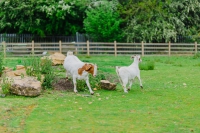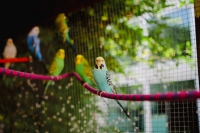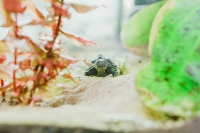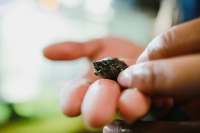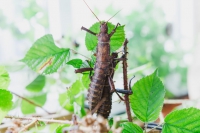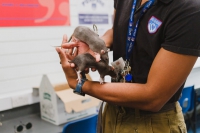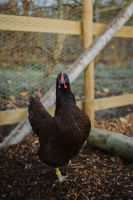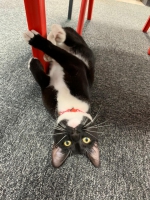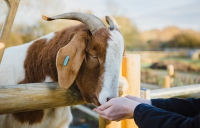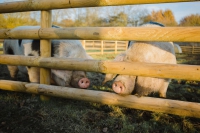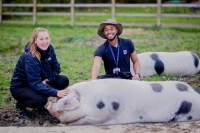Animal Care
Welcome to Animal Care
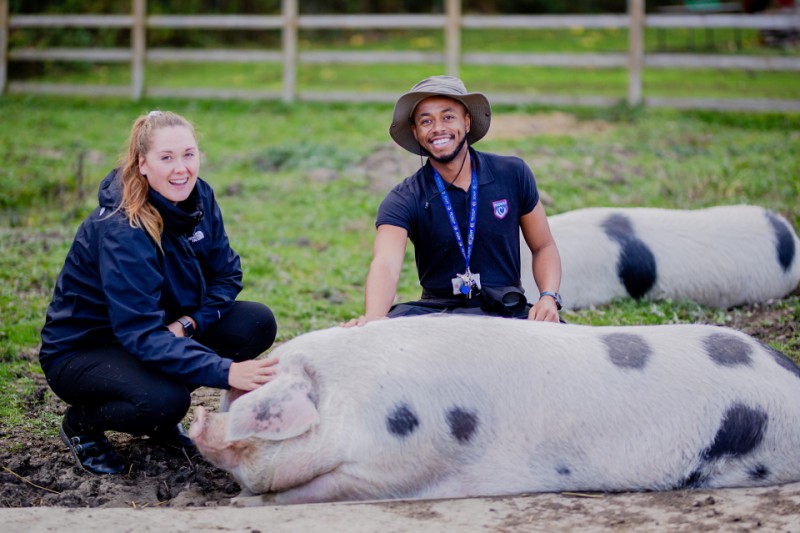
Here at Kirk Hallam Community Academy, we are extremely fortunate to house a multitude of species ranging from farm, avian, domestic, aquatic and exotic animals. This has enabled us to run the BTEC Level 2 First Award in Animal Care unlike many schools across the country. The Animal Unit department at KHCA allows for a fantastically unique experience for our students.
Course Overview

This BTEC First Award is designed to give an introductory overview of some of the key principles, knowledge, understanding and skills relevant to the animal care sector. Learners will study Unit 1 Animal Health, which is externally assessed via a written paper-based exam, as this knowledge and understanding are essential when caring for animals. Learners will also develop their safe animal handling skills while covering Unit 2: Animal Handling and restraint, which is vital to care for animals effectively. Learners will complete two other units:
- Unit 4: Animal Housing and Accommodation
- Unit 5: Principles of Animal Behaviour.
This qualification is intended for Level 2 learners, with Level 1 achievement possible, where appropriate, for some learners. This qualification also signposts links to the GCSE English and mathematics criteria to contextualise literacy and numeracy within a work-based environment. Upon successful completion of this qualification, learners could progress onto further study in a related area, for example, the BTEC Level 3 Nationals in Animal Management, or more broadly to other land-based subjects at Level 3.
See below for further details.
Outdoor lessons
Students are always keen to do practical work in school and practicals in animal care are no exception. Students are always pleased to do spend time with animals no matter what the weather this highlights how resilient they become. Students have an active involvement in animal husbandry and get to work with our animals every week. This enables them to imbed the skills and knowledge they taught in class and put them into practice.
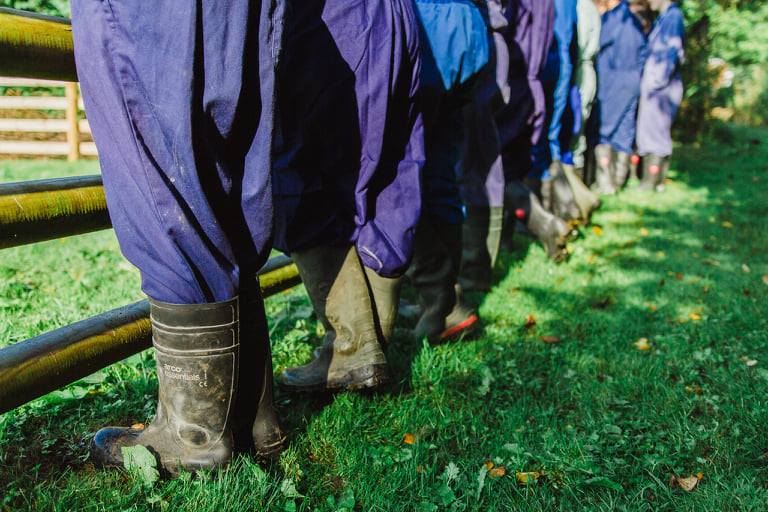
Practical lessons include:
- Health checking animals to see signs of health or use taught knowledge to identify signs of ill health
- Ensuring that enclosures for all animals are continuing to meet the 5 welfare needs.
- Grooming of animals when necessary
- Refreshing and replacing bedding
- Enrichment design for enclosures to ensure animals are appropriately stimulated
- Walking of hoofed animals
- Waste disposal
- Correct restraint methods and herding of animals
- Students also bear witness to medical procedures such as vaccination of animals when they occur throughout the year.
- Feeding and stock keeping
- Behavioural studies and research

Animal Care Units
The following shows a more detailed insight into some of the taught content for each unit...
Year 1
Unit 2: Animal Handling
Levels: 1 and 2
Unit type: Core
Guided learning hours: 30
Assessment type: Internal
____________________________________________________________________________________________________________
Unit introduction: Safe animal handling is a daily activity when dealing with animals. There are many different techniques used to handle and restrain animals in a commercial setting while also maintaining the animals’ welfare and safety. This unit will help you become competent in handling and restraining small animals, large animals, exotic animals and reptiles. It will also give you the opportunity to develop the essential skills you will need in order to handle and restrain animals in a commercial setting. You will learn about the reasons why it is necessary to handle and restrain animals, such as for health inspections, grooming or training. You will learn how to approach, handle and restrain animals safely, and build your confidence through practical assignments. These skills will be important skills for any career in the animal care sector. It is also important that you work safely and effectively with a variety of animals, so in this unit, you will develop safe working practices. These practices protect both your safety and the safety of the animals you handle. This will include learning about industry guidelines, health and safety legislation and animal welfare legislation. Being familiar with the hazards and risks associated with handling animals is crucial to any job in the industry. You will also learn about the control measures that can reduce the risks, and also about the procedure for reporting accidents when working with animals.
Learning aims In this unit you will:
A understand safe handling and restraint techniques
B demonstrate safe handling and restraint techniques used with animals.
Unit 4: Animal Housing and Accommodation
Level: 1 and 2
Unit type: Optional specialist
Guided learning hours: 30
Assessment type: Internal
____________________________________________________________________________________________________________
Unit introduction: Choosing the right kind of accommodation for animals and then preparing, maintaining and cleaning it is an essential part of looking after animals. In this unit, you will explore how to select and prepare animal accommodation in line with different animals’ needs. As well as learning about animal housing, you will gain an essential understanding of the purpose and characteristics of animal bedding, and how choosing the correct type of bedding can improve an animal’s welfare. You will investigate how and why different types of housing and bedding are suitable for the needs of different animals, and you will learn about the importance of good animal hygiene. You will also gain practical skills by preparing animal accommodation for use, checking and maintaining the accommodation, and cleaning it out effectively. This includes learning how to clean different types of feeding and watering equipment, as well as a range of different types of housing. These are all essential skills for anyone planning to work with animals, and you will learn how to use these skills both safely and effectively.
Learning aims In this unit you will:
A understand how to select animal accommodation
B prepare and maintain animal accommodation
C be able to clean out animal accommodation.
Year 2
Unit 1: Animal Health and Disease
Levels: 1 and 2
Unit type: Core
Guided learning hours: 30
Assessment type: External
____________________________________________________________________________________________________________
Unit introduction
Have you ever wondered why the vaccination of companion animals is so important? Have you ever wondered how ill health in animals can be spotted? Having an understanding of animal health is a vital part of working with animals in any field of the animal care sector. This unit will develop your knowledge and understanding of animal health, disease and parasite prevention, and how these link together. If you choose to work with animals, this unit will provide you with sound basic knowledge to provide the best possible care for animals. In this unit, you will learn how to assess the health of dogs, cats, rabbits, goats, chickens and bearded dragons, but these health assessment skills are easily transferred from species to species. Assessing animal health starts with observing the overall visual signs given by the animal’s appearance and behaviour before referral if appropriate to more in-depth veterinary tests for possible ill health in the animal. You will learn about some of the most common diseases and disorders found in the species you will assess, and gain an understanding of how to identify and prevent these common ailments. As part of this unit you will also learn about the parasites that you may find on or in the animals you will assess. You will learn how these parasites are transmitted, the effect they have on animals and how their transmission can be prevented.
Learning aims
In this unit you will:
A understand the essential signs of good and ill health in animals
B understand common diseases, their causes, transmission and treatment
C understand the signs, symptoms, prevention and treatment of common parasites.
Unit 5: Principles of Animal Behaviour
Level: 1 and 2
Unit type: Optional specialist
Guided learning hours: 30
Assessment type: Internal
____________________________________________________________________________________________________________
Unit introduction
In this unit, you will learn about the normal behaviour that we expect to see in animals, as well as abnormal behaviours that may be caused by an animal’s environment. A parrot that pulls out its feathers in captivity is displaying an abnormal behaviour. Knowing that certain behaviours are abnormal will alert the animal’s keeper to the fact that something is wrong. Animals kept in captivity need to be kept in an environment that fulfils their welfare needs, or else they may start to display abnormal behaviours. An environment that contains all of the stimuli needed to maintain an animal’s physical and mental health is known as an ‘enriched’ environment. Enrichment can be as simple as changing the layout of the animal’s enclosure or providing food in a variety of different ways. In this unit, you will also learn about animal behaviour by visually monitoring animals and recording the behaviours you observe. These observational skills will be useful in many careers in the animal care sector, when knowing how to observe an animal’s behaviour allows you to make better decisions about its welfare. For example, if you observed an animal displaying signs of aggression, you would probably judge that it was unsuitable for handling at that time. Being able to record observed behaviour and act on information in this way is a transferable skill.
Learning aims
In this unit you will:
A know what indicates behaviour patterns in animals
B understand the influence of enrichment on animal behaviour
C monitor and record the behaviour of a range of animals
"Learning outside the classroom can also help to combat under-achievement."- Ofsted 2008

